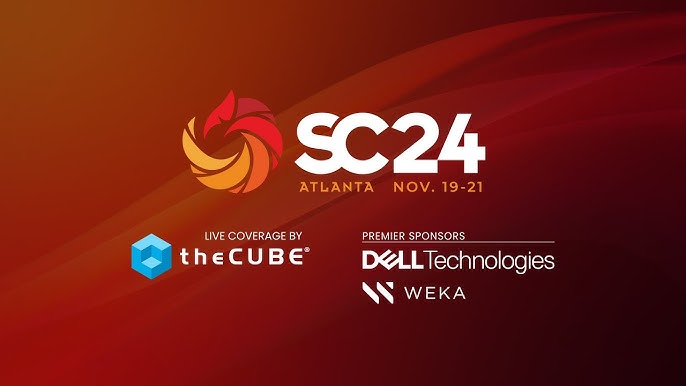 INFRA
INFRA
 INFRA
INFRA
 INFRA
INFRA
As we approach SC24 opening Tuesday in Atlanta, we’ve been talking on theCUBE about the rise of new supercomputing infrastructure concept which I’ve been calling “clustered systems.”
Over the past few years, we’ve been tracking how this concept has evolved and its game-changing role in the world of artificial intelligence, especially generative AI. At its core, clustered systems represent a fundamental shift in how we approach computing infrastructure, and they’re setting the stage for the next wave of innovation in AI and enterprise technology.
Clustered systems aggregate multiple computing unit such as servers, graphics processing units and networking components into a single, unified computing environment. This allows the systems to handle the kind of computational workloads that generative AI models demand, whether it’s training massive language models or running inference across diverse applications.
Though the concept of clustering isn’t new, its application to generative AI is groundbreaking. AI models today are far more complex, requiring immense scalability and performance. Clustered systems deliver that by distributing workloads intelligently, enabling enterprises to innovate faster and at scale.
Take Nvidia Corp., for example. It has been at the forefront of this shift, not just with its GPUs but with their entire ecosystem — NVLink, CUDA and its DGX systems. But it’s not just Nvidia driving this forward.
Companies such as Dell Technologies Inc. are advancing the infrastructure landscape with their PowerEdge XE9680 servers, which integrate Intel Corp.’s Gaudi 3 AI accelerators, and next-generation PowerEdge systems featuring AMD EPYC 5th Gen processors. These systems are built to scale AI workloads and provide the flexibility needed for training and inference. Dell’s approach shows how hardware tailored for AI can meet the growing demands of clustered systems, ensuring enterprises can optimize both performance and cost.
One of the critical things I’ve been talking about is what I call the“Gen AI Law” – Dave Vellante, my co-founder and co-host of theCUBE, calls it “Jensen’s Law,” after Nvidia Chief Executive Jensen Huang. We’ve seen this before with Moore’s Law during the PC revolution, where hardware advancements pushed software innovation forward.
Today, generative AI is creating a similar dynamic. The question now is whether the hardware you invest in today such as infrastructure optimized for training AI models can also serve your needs for inference tomorrow. Interoperability and scalability have become the name of the game.
Dell is addressing this challenge with solutions like their AI Factory, which integrates advanced infrastructure with Nvidia technology to optimize the entire AI lifecycle. From training large-scale models to deploying small, task-specific ones, the infrastructure is built for versatility. This kind of flexibility is critical in a world where infrastructure must evolve to support the growing diversity of AI workloads.
Generative AI is also shifting enterprises think about AI models. It’s not just about building massive models anymore; it’s about creating ecosystems of models, both large and small. Specialized, task-specific models are emerging alongside general-purpose ones, and clustered systems are perfectly suited for this multiscale AI future. They allow enterprises to handle everything from tiny models for edge use cases to sprawling, multibillion-parameter models for advanced applications.
Developers, too, stand to benefit immensely. With clustered systems, they can create scalable software that runs consistently across diverse environments whether in an enterprise data center or in the cloud. For instance, Dell’s rack-scale management solutions and HPC offerings are designed to give developers the tools they need to deploy and manage scalable software across hybrid environments. These kinds of advancements make it easier to test, iterate and deploy AI applications efficiently.
Jensen Huang made a profound statement recently: “The new unit of computing is the data center.” I couldn’t agree more. Enterprises are no longer looking at individual servers or nodes; they’re thinking holistically about their infrastructure.
If you’re serious about competing in the world of generative AI, you’re going to build your own supercomputer and connect it to the cloud to take advantage of its scalability and services. Supercomputing is powering superclouds.
Dell and many of the top AI server vendors are rolling out sustainable data center solutions, which are not only eco-friendly but also built for scalability. The focus is on direct liquid cooling to ensure that enterprises can achieve higher performance without the energy overhead typically associated with large-scale computing.
SC24 is where all of these ideas will come together with AI being fused into supercomputing for the masses intersecting with generative AI software as the core innovation.. This year, I’ll be watching several several key areas:
To me, the rise of clustered systems is nothing short of an industrial revolution powered by AI. Companies such as Nvidia, Dell, Amazon Web Services Inc. and Broadcom Inc. are pioneering advancements in hardware, software and connectivity that will redefine what is possible in AI. From generative AI applications to sustainable data center to cloud to edge technologies, the full potential of clustered systems is only beginning to be realized.
At SC24, we will see the new era of clustered systems enter the conversation for any enterprise looking to compete in the age of AI.
THANK YOU